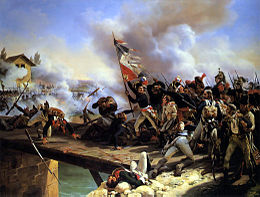Mass in tempore belli
The Missa in tempore belli (, Mass in Time of War '), Hob. XXII: 9 in C major for four soloists ( soprano , alto , tenor , bass ), four-part choir ( SATB ), orchestra and organ by Joseph Haydn was Composed in 1796. The fair is also known under the name "Paukenmesse".
Historical background
After Prince Nikolaus II. Esterházy took over the reign in 1794, Haydn asked Haydn to rebuild the Eisenstadt court orchestra, which was dissolved in 1790 . Haydn's obligations as a composer should be limited to delivering a new mass every year on the name day (September 8th) of Princess Maria Josepha Hermengilde . Haydn fulfilled this obligation in the years 1796 to 1802 (with the exception of 1800) with the composition of his six later masses.
The autograph of the Missa in tempore belli , like that of the Holy Mass Hob. XXII: 10, is dated to the year 1796, which is why the exact order of origin can no longer be clarified with absolute certainty. According to the latest research, it is generally assumed that the Holy Mass was performed first in 1796 and that the kettledrum was the second of the six masses.

Haydn himself chose the Latin name Missa in tempore belli of which recalls that Napoleon Bonaparte then in the War of the First Coalition , coming from Italy , Vienna threatened. The fair will be because of the timpani in the Agnus Dei also Paukenmesse called. These drum beats are a slowed-down image of the French army drum roll with a characteristic anapaestic rhythm . A quarter of a century later, Ludwig van Beethoven designed the impressive combination of the belligerent drum sounds with the request for peace in a very similar way in his Missa solemnis .
The mass was premiered on December 26, 1796 in the Piarist Church of Maria Treu in Vienna. For the Viennese performance, Haydn added flute, clarinet and horn parts to the orchestra that were not available in the Eisenstadt chapel. In Eisenstadt the mass was first heard on September 29, 1797.
Work description
The mass follows the sequence of the traditional ordinarium , which Haydn divides up as follows:
- 1. Kyrie eleison. Largo - Allegro moderato. Solos SATB, choir and orchestra
- 2. Gloria in excelsis deodorant. Vivace. Tutti
- 3. Qui tollis. Adagio. Bass solo, violoncello solo, tutti
- 4. Quoniam to solus sanctus. Allegro - Più stretto. Solos SATB, Tutti
- 5. Credo in unum Deum. Allegro. Tutti
- 6. Et incarnatus est. Adagio. Solos SATB, Tutti
- 7. Et resurrexit. Allegro. Solos SATB, Tutti
- 8. Et vitam venturi. Vivace. Soprano solo, Tutti
- 9. Sanctus. Adagio - Allegro con spirito. Solos AT, Tutti
Benedictus
- 10. Benedictus. Andante. Solos SATB, Tutti
- 11. Agnus Dei. Adagio. Solos SATB, Tutti
- 12. Dona nobis pacem. Allegro con spirito - Più presto. Solos SATB, Tutti
The line-up of the orchestra comprises: 2 oboes , 2 bassoons , 2 trumpets , timpani , strings and organ as well as ad libitum flute , 2 clarinets , 2 horns .
The performance lasts about 40 minutes.
literature
- Matthias Walz: Missa in tempore belli C major ("Paukenmesse"), Hob. XXII: 9. In: Hans Gebhard (Ed.): Harenberg Chormusikführer. Harenberg, Dortmund 1999, ISBN 3-611-00817-6 , pp. 411-413.
- Werner Oehlmann , Alexander Wagner : Reclams choral music and oratorio guide. 7th edition. Reclam, Stuttgart 1999, ISBN 3-15-010450-5 .
- Almut Runge-Woll: Missa in tempore belli [C major]. In: Silke Leopold , Ullrich Scheideler : Oratorio Guide. Metzler, Stuttgart 2000, ISBN 3-476-00977-7 , p. 321f.
- HC Robbins Landon : Haydn: Missa in tempore belli and other sacred works. 1996. Supplement to CD Sony SK 68255
Web links
- Mass in C major, Hob. XXII: 9 (Haydn, Joseph) : Sheet music and audio files in the International Music Score Library Project
- Free scores of Missa in tempore belli in the Choral Public Domain Library - ChoralWiki (English)
- Download in MP3 format (Creative Commons License)
- Harnoncourt and the Timpani Mass, essay
